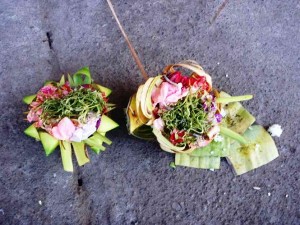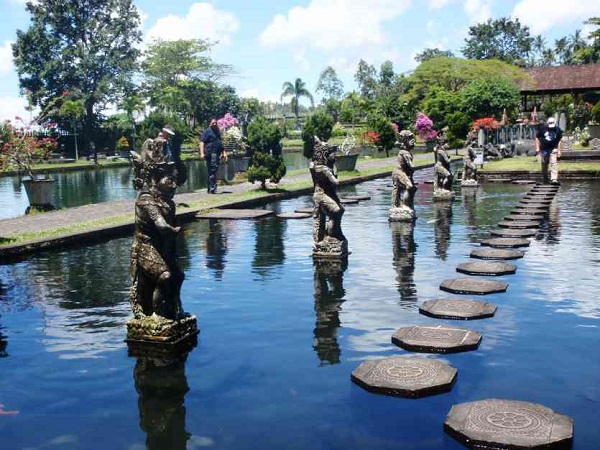Bali has often been described as Paradise Found, and when we first visited in 1997, the island was all that.
One of the stickiest images I took from that time was the sight of prepubescent boys and girls bathing naked in the river, unmindful of the gawking tourists in the passing buses overhead. The laughter was pure mirth while the frolicking recalled the rough and tumble childhood games of a more innocent era.

On our first trip, we toured the countryside in a mini-bus and had a passing glimpse of little girls being taught native dances by their elders in the front yard. It was easy to feel spiritual just seeing how solemnly people carried small reed baskets of flower offerings into neighborhood shrines and temples.
We also noted Bali’s strong similarities with India in the glut of Hindu temples with their carved murals depicting strange gods and goddesses, as well as good versus evil scenes from the Ramayana and Mahabharata.
But absent here was the dread one felt in India whenever traffic lights forced one’s cab to a halt. Immediately, hordes of beggars would descend on the hapless vehicle, and the familiar keening sound of the dispossessed would shroud the air. Dirty palms would be thrust unceremoniously at one’s face, or would furiously thump against closed windows, sounding very much like guilty heartbeats for the well-fed passenger.
You reluctantly hand over a few coins to get the ragged procession out of your sight, but then there’s always the next traffic light, the next intersection to worry about. Would it be an unwashed cortege of half-naked men next, or a band of limbless kids, ferocious and unforgiving as only schooled beggars can be?

There was none of that in Bali on our first visit. Street vendors abound, offering fresh fruits or souvenir crafts, but they quietly moved on at the slightest shake of one’s head. Even small children proffering trinkets never once extended an open palm to beg. Men waving a long list of services for hire and places to tour eagerly tried to catch one’s eyes, but did not persist once we walked past them.
This time around, the tourists were easy prey. Just past customs, a gaggle of money-changers at the airport called out their exchange rates, their babel of voices adding to a newcomer’s confusion.
Yup, loud voices to drown out their conscience, we jested at each other, noting that they bandied about an unconscionable rate of 100 rupiah for every peso, when the going rate was 270. Now the gouging begins, we thought wryly.
As in Boracay, tourism has diminished Bali. Now you’d have to riffle past the heavy curtain of batik merchandise and sarong, and move aside the cheap wood carvings at every corner to find the homespun character of the place.

The story of Candidasa, a tourist enclave on the eastern coast where we stayed in March this year, is instructive. To build more hotels for the expected onslaught of free-spending guests, the local government chipped down the offshore reefs for their limestone. But the reefs were not only pretty; they had also prevented the sea from gobbling up the beaches. With them gone, thunderous waves regularly stage corrosive incursions into the beachfront areas, sweeping away sand, shells and safety. The sea, so blue and serene in the distance, now comes with a warning and a girdle of sharp rocks that ward off the white-capped waves and threatening tides.
Check first if the local children are swimming before you go in, the hotel staff cautioned when we asked about the beach. There’s always the pool, they added, as if to console us.
With several airlines now offering direct flights to Bali and the crush of tourists an expected phenomenon, we’ve prepared a list to help you enjoy Bali without going ballistic:
1. Go slow and feed your senses. Leave time for several stops along the road so you can appreciate the culture that sets Bali apart from other destinations. Watch for colorful street parades that may be a wedding party or a funeral march, but remember that they’re not a public spectacle but are part of the strong belief system that defines everyday life among the Balinese. When people here make an offering, the incense smoke might as well be a brawny arm reaching back into thousands of years and pulling up the past to copy-paste on present-day Bali.

2. Hold on to your rupiah. You might feel you’ve become an instant millionaire, with your money suddenly sprouting a gazillion zeroes when changed into local currency, but resist the temptation to spend like one. You’d find your millions don’t really go that far, what with popular sites charging different admission rates for locals and tourists. To get good bargains, stay away from Caucasian guests who flash their dollars and gush at how cheap stuff here are.
3. Take your time and haggle. Settle down, read the tour brochures and make a quick calculation before accepting the first offer from your hotel driver just because his high-pressure tactics are getting on your nerves. Learn to haggle-it’s expected.
4. Make your own itinerary. Those package tours often turn out to be shopping expeditions, with your tour guide getting hefty commissions. This is particularly true of the areas around Ubud, where your tour includes a stop at the jewelry, batik, art and leather shops. Just say no; you can get better wares at better prices elsewhere (except the airport, of course).
A good option is to hire a vehicle (driver, fuel, toll and taxes included in the price) for an eight- or 10-hour day and give him the list of places you’d like to see. If you can afford it, set aside a day for a guided tour complete with meals, and another day for touring other spots of your choice.

5. Eat, pray, love the food. Try some of the local dishes: gado-gado or assorted vegetables in peanut sauce, and different kinds of satay (spicy barbecue). Forget the nasi goreng, which is usually just rice, some veggies and a Western entrée, often fried chicken.
But try the babi guling (similar to our lechon de leche) and the bebek betutu (Bali’s version of roast duck) that are considered special treats here.
6. Dial down your expectations when going to the beach. Except for the rather crowded but family-friendly PadangPadang beach that one reaches via steep winding steps inside a cave (and where Julie Roberts frolicked in the movie “Eat, Pray, Love”), you’d find that our beaches in Boracay, Batangas and Bicol are more pristine, with the corals more intact and our marine life richer and more diverse.
7. Do a temple run. You have no excuse, with the sheer abundance of temples around. Most picture-worthy is the Besakih, considered the Mother temple, the Uluwatu temple that sits on top of a cliff and the Tanah Lot, which is on a rock overlooking the Indian Ocean. Take note though that you need to be appropriately dressed: with sleeves, in sarong (for both men and women) and a sash. For other temple protocol for women, ask your tour guide. Also, beware of touts who encourage you to enter sacrosanct areas in the temple, only to charge you a hefty “donation” after.
8. Park yourself in a park. There are plenty of greens, lagoons, ponds teeming with koi and decorative waterfalls in most hotels, as calming nature scenes seem to be synonymous with Bali. But there’s also Tirta Gangga (“water from the Ganges”), which used to be the private garden of a rajah. You can spend so many pleasant hours in this one-hectare water palace with its an amazing pools, ponds and fountains, artful bridges, lush gardens and statues of gods walking on water. Definitely a refreshing sight in hot and humid Bali.

But strike off your list the botanical garden in Ubud, where all you’d see for Rp50,000 (about P250 per head) are overgrown weeds, a few pots of threadbare orchids (passing themselves off as an “orchidarium”), a labyrinthine maze teeming with insects, and wooden picnic tables blooming with dirty plastic cups and food wrappers. You’d be better off watching “Epic” in 3D for a glimpse of lush foliage.
9. Beware of monkey business. The Uluwatu temple is famous for its location (atop a cliff), the kecak fire dance where about 100 men imitate with their voices the cak-cak sound of birds, and its felonious primates. Take off your trinkets, watches, cameras, eyeglasses and assorted bling lest the monkeys in the wooded park nearby fancy them.
Quick as Manila’s street urchins, they’d grab your stuff and run off, but oddly enough, people selling food and souvenirs on the temple grounds always manage to coax them into returning the stolen stuff. For a hefty tip, of course, leading some guests to suspect monkey business between the naughty primates and the even naughtier vendors.

10. Forget Britney or Gwyneth; there are only four common names here. Don’t be surprised to see store signage, political posters, restaurants and shops sporting only four names: Wayan, Made (Ma-deh), Ketut or Nyoman, which are the names of the eldest, the second, third and fourth male child in the family. They’re also the common names for the daughters of the house, except that each birth order for females is preceded by a ni: Ni Wayan (for the eldest daughter), Ni Made (for the second daughter), and so on. No Hollywood names for the Balinese who apparently put a premium on birth order and family hierarchy.
11. Blending with the natives isn’t always a good idea. While riding the bemo (small mini-buses) is a good way to experience how the locals live, know that you’re in for a long wait since public transpo is a problem in Bali and disappears from city streets by 5 p.m. If you do find one, you’re bound to get a cramped and bumpy ride; apparently, the bemo moves not only people, but stuff as well. The bemo we hailed after half an hour’s wait was filled to the roof with old carton boxes for recycling so our necks were at a permanent 90-degree angle throughout the hot 30-minute ride. The two-way ride for four cost us Rp400,000, when an 8-hour private transport in air-conditioned comfort would have totaled R300,000. So much for shucking off our tourist ways…
12. Practice your lotus pose. In Bali, we’ve finally found an airport that’s possibly worse than NAIA.

Set aside Rp150,000 (about $15) for the terminal fee, the hotel personnel said. No dollars, no credit cards, only the exact amount in cash. Fine, we thought, since that’s about the same amount for the terminal fee at NAIA, the Philippine airport.
But wait, there are chairs at the NAIA; you can check in early and loll around the pre-departure area without risking varicose veins from standing too long.
Not so at the Denpasar airport where we found, to our grief, that we had come too early for our flight and were not allowed to check in early. Come back two hours before your flight, we were told gruffly.
With no chairs in sight in the humongous airport, we had to wait out the three hours in the coffee shops and restaurants within the compound, where we quickly became over-caffeinated, bored and poverty-stricken. Smart way to bilk tourists of their remaining rupiah, we thought, as we glanced at the overpriced entrees in one of the few coffee shops with WiFi.
So what was the Rp150,000 for, we asked the customer service guy who looked at us like we had just hit him with a folding chair. Could they be promoting a unique way to practice yoga, what with tourists assuming all manner of lotus poses on the cold floor, the better to guard their stuff, work on their laptop and fight off ennui?
Whew, chairs must really cost a lot in Bali if, after paying $15 apiece as exit fee, the poor tourist still winds up on the floor. I guess people don’t take things sitting down in Bali.
Well, at the very least, Bali’s airport makes you appreciate NAIA belatedly. So much for paradise. •









































